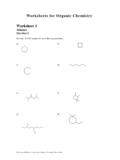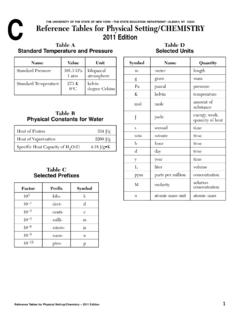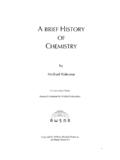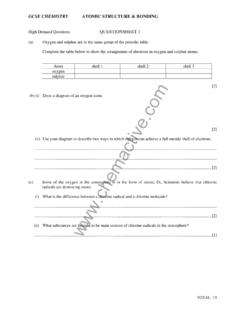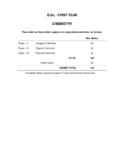Transcription of Chemistry Revision Notes 2012 - Skinners' School …
1 Edexel IGCSE Chemistry Revision Notes -0- I G C S EI G C S E C h e m i s t r y C h e m i s t r y T r i p l e T r i p l e A w a r dA w a r d R e v i s i o n G u i d eR e v i s i o n G u i d e Topic Page Introduction to Chemistry 1-6 Atomic Structure 7-8 Structure and Bonding Ionic Bonding 9-10 Structure and Bonding Covalent and Metallic Bonding 11-14 Organic Chemistry - Alkanes 14-17 Organic Chemistry Alkenes / Addition Polymerisation 18-19 Organic Chemistry Alcohols / Condensation Polymerisation 20-22 Calculations 23-32 Periodic Table 33-39 Reactivity Series and Metal Extraction 40-44 Electrolysis 45-48 Energetics 49-51 Acids, Bases, Salts and Neutralisation 52-58 Preparing and Analysing Salts 59-63 Rates 64-65 Equilibria and the Haber Process 66-70 Edexel IGCSE Chemistry Revision Notes -1- Edexel IGCSE Chemistry Revision Notes -2- States of matter SOLIDS: (particles in contact.)
2 Attractions hold them in fixed positions) have definite shape and volume LIQUIDS: (particles in contact, and attract each other, but are free to move around) have a definite volume they take the shape of a container GASES: (particles widely separated; little or no attraction; move freely until they collide) spread out (diffuse) and into all the space that is available and will mix completely with any other gas(es) in the same space are compressible ( can be squashed up into a smaller volume) The following diagram shows the names given to the various changes of state. When substances change state, energy is involved.
3 Change of State Energy Change Reason for energy change Solid Liquid Heat taken in Energy needed to break bonds between the particles in the solid Liquid Gas Heat taken in Energy needed to break the forces between the particles in the liquid Liquid Solid Heat given out Energy given out as particles bond together in the solid Gas Liquid Heat given out Energy given out as particles bond together in the liquid SOLID LIQUID GAS/VAPOUR Evaporation (at any temperature) Boiling (at fixed temp = ) Melting (at fixed temp = ) Freezing (at fixed temp = ) Condensation (at fixed temp = ) Sublimation Sublimation Edexel IGCSE Chemistry Revision Notes -3- Kinetic Theory The properties of solids, liquids and gases can be explained by kinetic theory.
4 Kinetic theory states that matter is made of tiny particles that move all the time. The main points of the theory are; All matter is made of tiny, invisible, moving particles. The particles move all the time. The higher the temperature the faster they move. Heavier particles move more slowly than light ones at a given temperature. DIFFUSION: this is the mixing of atoms or molecules due to their continuous and random motion. Mixing of bromine vapour and air. BROWNIAN MOTION: the constant random movement of tiny particles ( smoke particles, or pollen on a drop of water) is caused by collision with (invisible) air or water molecules, which are themselves in continuous and random motion.
5 Experiments using gases diffusing in a tube are used to examine the motion of the particles. Ammonia and hydrochloric acid particles under Brownian motion as they hit air particles in the tube. When they meet white smoke (ammonium chloride) forms. As the ammonia travels farthest along the tube we know that; The ammonia particles move faster than hydrochloric acid particles. The ammonia particles are lighter than the hydrochloric acid particles. Edexel IGCSE Chemistry Revision Notes -4- Heating and Cooling Curves We can use kinetic theory to explain changes in state when substances are heated or cooled. In a solid the particles are held in position by bonding to their neighbours.
6 (A on the graph). As the solid is warmed the particles vibrate but cannot move. (Between A and B on the graph). When heated enough the particles vibrate so much that they can tear themselves free from their positions, and the substance melts to a liquid. At the melting point heat needs to be added to melt the solid and break the bonds between the particles, so the temperature doesn t rise until it is all liquid. (Between B and C on the graph). As the liquid is heated up the particles gain energy. (Between C and D on the graph). At the boiling point heat needs to be added to change break the forces between the particles in the liquid turning the substance into a gas.
7 Temp time (steady heating) A B C D Edexel IGCSE Chemistry Revision Notes -5- Elements, Mixtures and Compounds THE ATOMIC THEORY This theory assumes that all elements are made up of "atoms". If you were to divide a lump of an element into smaller and smaller pieces you would eventually come to a piece that could not be divided any further - a single ATOM of the element. Atoms are therefore very small. We can see this if we dilute a solution of potassium manganate(VI) many times. It is still coloured even when it is very dilute. Definition: An atom is the smallest particle of an element that can exist or take part in a chemical change.
8 MOLECULES All elements are made up of atoms. In some gaseous elements ( argon) single atoms move around freely. But in other gaseous elements, single atoms cannot exist on their own at ordinary temperatures: in these elements the free-moving particles consist of pairs of atoms. The two atoms forming a pair (a MOLECULE) are joined together by a chemical "bond". This is the case with hydrogen (H2), oxygen (O2) and nitrogen (N2). Such substances are said to be diatomic. An ELEMENT is a pure substance made up of only one type of ATOM. A COMPOUND is a pure substance which contains two or more elements, chemically bonded together in a fixed proportion.
9 A MIXTURE is a group of substances that are not chemically bonded together. Compounds Mixtures Proportions of elements are fixed. Proportions may vary. Properties different from those Properties are simply those of of the elements. the separate elements. Cannot be separated into elements Can be separated by a physical without chemical reaction. change ( dissolving one of the elements) There is usually an energy change No energy change when the when a compound is made from elements are mixed. its elements. Edexel IGCSE Chemistry Revision Notes -6- Separation Techniques 1. SOLID & LIQUID (a) If the solid has not dissolved in the liquid ( is suspended in the liquid), the two substances can be separated by FILTRATION.
10 The liquid filtrate passes through, the undissolved solid residue stays on the paper. (b) If the solid has dissolved in the liquid, forming a solution:- (i) If only the solid is required, it is obtained by EVAPORATION. (ii) If the liquid is required, it is obtained by DISTILLATION. The solution is placed in a flask and heated. The liquid evasporates, and its vapour passes into a condenser, where it cools and turns back to liquid. (The solid remains behind in the flask as a residue). Note The thermometer bulb should be at the level of the condenser. 2. LIQUID & LIQUID (a) Immiscible liquids - by using a SEPARATING FUNNEL When two liquids do not mix ( paraffin and water), they can be separated simply by running off the denser liquid from a separating funnel by opening the tap.
